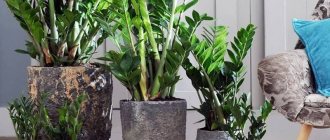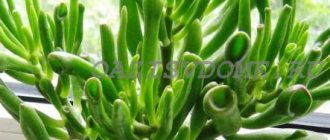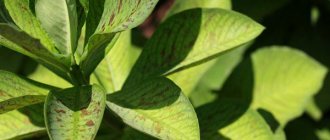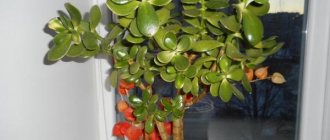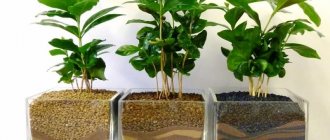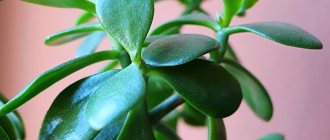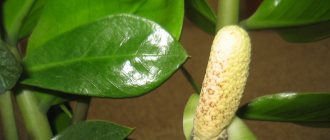Zamioculcas is a large evergreen plant from the araceae family. Grows in the form of a bush. Its homeland is the eastern, mountainous part of Central Africa. The leaves are leathery, small, located on long branches.
Dear readers! For you, we have created communities on social networks in which useful articles and interesting ideas are published several times a day! Subscribe and receive useful content in a convenient format!
The stem is thickened and short. The root system consists of many tubers protruding slightly from the ground. In a room or winter garden, Zamioculcas can reach a height of 1 m. Currently, several dwarf varieties have been bred, the height of which does not exceed 60 cm, which is very convenient for small spaces; such Zamioculcas are easier to care for.
Reference! Until the mid-90s of the last century, Zamioculcas was practically unknown to a wide range of amateur gardeners. Only in 1996 was it first presented at a flower exhibition in Holland, and in 2007 the first cultivar was created - a miniature form.
Now Zamioculcas is becoming increasingly popular. It is valued for its beautiful appearance, unpretentiousness and ease of care. The second popular name for Zamioculcas is the dollar tree.
According to the traditional Chinese teachings of Feng Shui, it is believed that he, like the crassula (money tree), is responsible for the financial well-being of the owners of the house.
And if the plant is healthy, well-groomed, with clean leaves, then wealth in the house will increase.
Currently, you can buy this flower in almost any flower shop, and the prices for it are not so high.
Caring for Zamioculcas after purchase
You should not replant the dollar tree immediately after purchase.
Wait a few days, let it acclimatize to the new conditions and the new microclimate of your home. A ceramic or clay pot is best suited for planting, since the roots of Zamioculcas are powerful and, when growing, can simply tear the plastic container.
The volume of the pot should not be large, about 3-4 cm larger than the diameter of the root system.
Growing conditions or how to care for it?
Growing zamiakulkas at home is not at all difficult. You just need to remember the original growing conditions. Its homeland is the mountain plateaus of Central and Eastern Africa. Consequently, it loves warmth, bright sunlight and very moderate watering. Let's take a closer look at some of the features:
Temperature
During the period of active growth (from April to September), the optimal temperature will be +25.
It also tolerates an increase to +30. In the summer, you can take the zamioculcas out into the fresh air, where the dollar tree will feel very good. In winter, during the rest period, the temperature should not fall below +12. Can't stand sudden changes or drafts.
Humidity
Spray with settled warm water, not often, about once a week and little by little.
The leaves are periodically wiped from dust with a damp cloth (you can use special polishes to give them shine). It will be very good if you place the pot with zamioculcas in a tray filled with damp moss or small pebbles, which should be moistened from time to time.
Lighting
Loves bright but diffused light. It should be shaded from direct sunlight, otherwise burn spots may appear on the leaves. Can be placed on a south, south-west window or a place near a window.
When is support needed?
Adult specimens of Zamioculcas can reach a height of 1 m.
In this case, the branches under their own weight will fall apart and the Zamioculcas will fall to one side, which can lead to the branches of the flower breaking.
As a support, you can use a ring made of strong wire or wood.
Where is the best place to put a dollar tree?
While the dollar tree is young and small in size, as mentioned above, a south or southwest window is suitable for it. Large flowers are very good for outdoor display.
What does Zamioculcas look like?
In nature, Zamioculcas reaches up to 1 m in height. The plant has no branches, but only compound leaves that grow from the tuber. The bright green leaves of Zamioculcas are quite large, with a waxy coating. Leaf blades and tubers can accumulate moisture.
Zamioculcas is undemanding in care and is perfect for novice gardeners. But before purchasing this plant, it is worth considering that all its parts are poisonous. The pot with zamioculcas should be placed away from small children and pets. When carrying out any plant care procedures, gloves should be worn.
Bloom
In indoor conditions, Zamioculcas rarely blooms.
To do this, create optimal care conditions for it, one of the main ones being compliance with the temperature regime in winter. If all goes well, the dollar tree will delight you with flowering.
The inflorescence is not quite ordinary - it is an ear, reminiscent of corn, white with a yellowish tint, bordered by a greenish blanket.
The bud comes from the base of the flower, from the ground itself, just like the leaves. From a botanical point of view, the structure of the flower is very interesting. The upper part of the spadix consists only of male flowers, and the lower part only of female flowers. Moreover, they are separated by several rows of sterile flowers. It is clear that with this arrangement, self-pollination of Zamioculcas is impossible.
Humidity
Zamioculcas itself is able to retain moisture in its fleshy leaves and does not need air humidification and spraying too much. Perhaps he will only need spraying and a shower in hot and stuffy weather (during a shower, the pot should be covered with a bag).
- But periodically wiping the leaves from dust is a good idea. Any soft fabric and your accuracy will do for this (leaves can easily be torn off if you pull).
Transfer
The best time to transplant zamioculcas is spring.
Young plants are replanted annually. Adults - only when the roots begin to emerge from the drainage holes. Take a pot that is just a little larger. Be sure to add drainage, about 1/4 of the pot.
The soil should be light, moisture- and breathable, with an admixture of sand. You can add fine expanded clay to it. The substrate is good for cacti and succulents.
The root system of Zamioculcas is dense tubers, quite fragile. If they are damaged, the plant may die.
Therefore, it is better to replant using the transshipment method, with a lump of earth. In this case, the tubers cannot be completely covered with soil. They should be open at the top by about 1 cm.
Very large, mature plants are not replanted, but simply replace the top layer of soil in the pot with a new, more fertile one. To do this, carefully, so as not to damage the tubers, remove 5-6 cm of soil, and then just as carefully add fresh soil.
Brief description of cultivation
Due to the unpretentiousness of the plant, its cultivation is not associated with significant difficulties.
For comfortable living, it is necessary, first of all, to take care of the soil mixture. You can prepare the soil yourself from equal parts of leaf soil, turf soil, peat and sand. You can use a ready-made commercial substrate for succulents or cacti. The main requirement for the soil for zamioculcas is looseness and good air permeability , combined with a neutral reaction. It is also necessary to arrange drainage, ¼ of the pot thick.
The keys to success are proper lighting, temperature, watering and humidity. Occasionally - fertilize, transplant into a larger pot.
Reproduction at home
Zamioculcas is most often propagated by division during transplantation.
The tubers are cleared of soil and carefully separated from each other. Each division should have a leaf with a bud and several roots. Young plants are planted in separate small shallow pots. At first after planting, caring for them consists only of very limited watering. The first feeding is applied only after a new young leaf appears.
You can also propagate Zamioculcas from leaf cuttings.
To do this, use a sharp knife to carefully cut off a leaf with a bud at the base of the dollar tree. The cut area is immediately sprinkled with activated carbon powder.
The resulting cutting is dried for several hours. Then they are planted in a container filled with loose soil, slightly buried and watered a little. The container with the cuttings is placed in a warm place, out of direct sunlight. Usually the roots appear within a month. But more is possible, so be patient.
Water the cuttings exclusively by spraying, infrequently and little by little. To speed up the process, you can cover the top with plastic film to create a greenhouse effect and reduce evaporation. However, in this case, the container with the cuttings is ventilated from time to time to avoid rotting.
Types of homemade Zamioculcas with photos and names
He has few varieties. They are slightly, but still different from each other, and connoisseurs will be able to choose the option they like.
Zamioculcas zamiifolia
It is distinguished by thick stems and leaves that look so beautiful that the plant can easily be confused with an artificial one.
Zamioculcas zamifolia is the most common variety
Zamioculcas zenzi (zamioculcas cv zenzi)
A compact, stocky plant with thick leaves, grows up to 60 centimeters. The variety was bred in Holland. Does not require supports.
A very unusual castle with funny thick leaves. Somewhat reminiscent of krasula (money tree)
Zamioculcas variegate
This plant variety is native to the island of Madagascar. It is almost impossible to find in local nurseries. Its distinguishing feature is its variegated leaves.
Handsome!
Zamioculcas lanceolata
It is distinguished by thin branches and elongated oblong leaves, shaped like a lancet. Reaches 1 m and above in length. His homeland is Holland.
Black zamioculcas (zamioculcas blak raven)
He is also called Raven or Raven. The stem looks a bit like a raven feather. Outwardly, he looks almost the same as other zamiki. Only its leaves are so dark that they can easily be mistaken for black. If you look at the leaf against the light, it will appear green.
Important! Young shoots are usually green and darken over time. The variety was bred in Holland, very expensive and rare.
Black zamioculcas, but young branches remain green for a while
Zamioculcas purple (zamioculcas black leave ex Korea)
A very rare and expensive variety originally from Korea. Young shoots are light green and darken over time. If you look at the leaves in the light, you can see that they have a purple tint.
Don't believe it if someone tells you that this is a compact variety. In fact, this Zamioculcas grows up to 100-120 centimeters.
Trimming
Pruning zamioculcas is needed to form the crown of the plant, improve its illumination, and remove yellowed, diseased or bare branches.
Using pruning, you can give the crown of a dollar tree a ball shape.
It is best to prune during the period of active growth, in spring or summer. If you do this during dormancy, winter sleep, the branches will be weak and pale, and the appearance of the plant may deteriorate.
Rejuvenation
Plant rejuvenation is the division of an old, heavily overgrown zamioculcas bush during its transplantation.
In addition to formative pruning, rejuvenating pruning is also carried out. This means that it is necessary to remove old branches that have lost their decorative appearance. After pruning, ugly stumps often remain at the base of the flower. They can be very carefully removed during transplantation.
Carefully! Zammokulkas juice contains substances that, if it comes into contact with the skin, can cause burning, redness, and allergic reactions in the form of a rash. Therefore, all work on transplanting, planting, propagating and pruning should be carried out only with rubber gloves. But for this reason, you should not refuse to grow such a beautiful, spectacular flower. When it stands on a windowsill or on the floor, it does not harm anyone.
Temperature
Homemade zamioculcas is a heat-loving flower. And from spring to autumn, it is advisable to maintain the temperature in the room with the plant within +22...+25 degrees. Cooler conditions are allowed in winter. But it is worth remembering that the mark of +16 degrees is critical for the culture.
At any time of the year, it is also important to provide the zamioculcas with an influx of fresh air. Therefore, ventilate the room regularly, and in the summer you can even send the flower to the balcony or garden. But remember that the plant does not tolerate drafts well. Therefore, during ventilation, take the pot to another room. And when growing on a balcony or in the garden, choose closed places for zamioculcas, where there are no sharp gusts of wind.
Watering
Watering all year round should be very moderate.
As they say, “it’s better not to top up than to overfill,” because over-moistening of the soil causes rotting of the roots. Excess water from the pan is immediately drained, preventing it from stagnating.
In the summer, water the zamioculcas when the soil in the pot dries well. In winter, even less often, 1-2 times a month is enough. Thanks to its tubers, thick stems and dense waxy leaves, the plant, like succulents and cacti, has the ability to store moisture and then use it as needed.
Attention! Overwatering is worse than drought for Zamioculcas! Remember this when caring for your flower.
Origin and appearance of the Dollar Tree
The birthplace of this interesting plant with such an unusual name is East Africa. Distributed in Kenya, Mozambique, Zanzibar, Zimbabwe, Tanzania and Madagascar.
The first mention of the plant, described as Caladium zamyefolia, appeared in 1828. The description belonged to the botanist and collector of tropical plants Conrad Loddiges. Then, in 1856, he is mentioned by Heinrich Wilhelm Schott. The final modern name, Zamioculcas zamiifolia, was given to the plant by the director of the Berlin Botanical Garden, Adolf Engler, in 1908. It appeared as indoor plants quite recently, in the late 90s - early 2000s, immediately becoming one of the leaders in popularity.
The plant received its name due to its similarity with zamia, which belongs to the Sagovnikov family.
On the right is Zamioculcas, on the left is Zamia
Zamioculcas belongs to the genus of evergreen semi-succulent plants from the aroid family, being a close relative of Monstera and Dieffenbachia. Like many aroids, Zamioculcas is poisonous. Under the ground there is a root - a powerful tuber resembling a potato. This is a modified plant trunk. Each tuber produces 4–6 odd-pinnate leaves. Each leaf has a stem or axis (rachis) - erect and thick. Dark green leaf blades diverge from it in different directions. Their shape is ovoid, the surface is glossy, shiny, leathery. There are from 8 to 21 leaf blades on each stem.
The flower is rather inconspicuous. The inflorescence has the shape of a spadix, 8 cm long, surrounded by a light green veil. Formed on a short and thick peduncle. Flowers are of different sexes: female flowers are located at the bottom, male flowers are located on top. Between them there is a zone of sterility, which makes self-pollination impossible.
Under natural conditions, after the flower is pollinated by the wind or crawling insects, brown berries containing a seed inside are formed on the cob. At home, the seeds practically do not ripen, so if desired, the flower can be carefully removed immediately or done after flowering.
Zamioculcas blooms at home quite rarely and only in adulthood. To make a plant bloom, you need to provide it with light, water and thermal conditions that are as close as possible to natural ones:
- A sufficient amount of light will be provided by a location on a south or east window.
- Water infrequently.
- Feed with fertilizers for succulents from April to August 2 times a month.
- Ventilate the room.
- Wash or wipe the leaves periodically.
Zamioculcas flower looks inconspicuous
If the zamioculcas blooms but does not produce new leaves, this may indicate senescence. In this case, it’s time to think about propagating the plant in order to replace it with a young one.
Under natural conditions, the plant can be found in mountainous rocky areas, on mountain plateaus in drought conditions, in lowland forests with partial shading. Over the years of its existence, the plant has completely adapted to poor rocky sandy soils. Zamioculcas is able to grow in places with extreme weather conditions, where drought is replaced by heavy rains.
Zamioculcas can withstand sun and shade
It is very easy to keep Zamioculcas at home. This spectacular beauty is one of the most unpretentious houseplants. Caring for it is not difficult even for an inexperienced gardener. This plant will feel equally great in a small room and in a huge office space.
Zamioculcas has acquired the nickname of the “unkillable” plant, it is so easy to care for. However, the plant may die if watered too much.
Zamioculcas will give any room a luxurious look
Zamioculcas is a large plant. The length of its leaves can be from 1 to 1.5 meters. In 2007, Dutch breeders introduced a new miniature variety of this plant, the length of the leaves does not exceed 60 cm and the leaf blade is smaller.
Feeding and fertilizer
Feeding is another component of care.
During the period of active growth (from April to September) feed 1-2 times a month, no more often. Typically, fertilizers are used for cacti and succulents. The concentration of the feeding solution can be made less than indicated in the instructions for use of the drug.
In general, the situation with fertilizing is the same as with watering: it is better to underfeed than to overfeed. Young, newly transplanted zamioculcas plants are not fed until new fresh leaves begin to appear.
Important! In winter, during the dormant period (from October to March), feeding is stopped.
What do dollars have to do with it?
It should be noted that this plant really, in some incomprehensible way, attracts businessmen. Back in 1905, the then “Ostap Benders” tried to pass off the “Emerald Palm” as a new species formed by crossing a palm tree and a fern. The “scientific sensation” was exposed and Zamioculcas was forgotten for many years.
Recognized authorities in floriculture - the Dutch - did not give up attempts to introduce this truly beautiful plant into culture. Selection required the availability of seeds. And since it is almost impossible to obtain full-fledged zamioculcas seeds in a temperate climate, they were bought in Africa. Specimens of plants with any unusual qualities were also purchased there - variegated, dwarf, lanceolate, etc.
Local residents quickly realized that the previously useless grass could bring at least a small income - and they enthusiastically began harvesting “wild plants.” Hence the name of the plant. They pay for it in foreign currency, which means dollars.
The Dollar Palm's star rose in 1997 when its sales at Dutch flower auctions exceeded all expectations. Moreover, 90% of the plants went to Russia.
***
About how words are born: a squirrel in Kazakh is called “tyyn-shishkan”, translated as “penny mouse”. In tsarist times, a squirrel hunter was paid 1 kopeck. The money is no longer the same, but the animal forever remains a “penny mouse.”
Although, who knows what the African shamans whispered over Zamioculcas...
Diseases and pests
Zamioculcas is very rarely affected by pests and diseases.
Sometimes scale insects, spider mites or aphids appear on it. If they are detected, it is necessary to thoroughly treat the plant itself and the soil in the pot with a solution of a suitable insecticidal preparation.
If you don’t want to use chemicals, you can try some folk remedies to control pests. For example, from spider mites, the plant is pollinated with ground sulfur (this should be done outside the living room).
Treatment with a low concentration tobacco solution also gives a good effect. To get rid of aphids, sometimes it is enough to simply wash the crown under a strong stream of water (the soil in the container with the flower must be covered with film so as not to flood the tubers).
Spots on the leaves may be the result of a fungal infection. To combat it, appropriate drugs are also used. The appearance of diseases is usually a consequence of improper care. For example, with excessive watering or stagnation of water in the pan, stem rot is observed - the leaves begin to dry out and gradually fall off.
How to revive a houseplant?
The question often arises: how to revive zamioculcas that has begun to rot?
You need to immediately remove it from the pot, carefully free the roots from the ground and carefully examine them, rinse thoroughly in a weak solution of potassium permanganate.
Cut off all rotten areas with a sharp knife and peel back to healthy tissue. Be sure to sprinkle the sections with activated carbon powder. Let them dry for several hours.
In the meantime, also treat the pot with a solution of potassium permanganate, fill it with fresh soil and plant the zamioculcas again. Don't water it for a while. In the future, to avoid any troubles, try to avoid mistakes in care.
Possible mistakes during care
Let's look at some of the most common mistakes associated with home care:
- Excessive watering. Signs: leaves turn yellow and gradually dry out. The roots and stem begin to rot. Replant, and immediately.
- Insufficient lighting. The plant loses color, the branches become thin and elongated. Appearance deteriorates. Move to a more suitable, illuminated place.
- Insufficient air humidity. This is especially true in winter, when dry air comes from hot heating radiators. The tips of the leaves become dry and brittle. Spray it more often with warm, settled water or place the dollar tree pot in a tray filled with damp moss, expanded clay, pebbles, and shells, which are moistened from time to time.
Attention! If the old leaves turn yellow but new branches with green leaves appear, this is normal, just trim off the old leaves.
Zamioculcas grows very slowly. Moreover, this does not depend on the conditions of its maintenance, the same thing happens in nature, this plant has such characteristics. Sometimes it can simply “freeze” for a while and not grow at all. There's no need to be scared, it's okay. If the zamioculcas looks healthy and there are no pests, everything is fine.
Signs and superstitions
There are many signs and superstitions associated with the dollar tree. In addition to the ability to attract money, which is attributed to Zamioculcas, it is often called the flower of celibacy. The plant received this name because its presence allegedly makes it difficult for a single woman to find a suitable man. To eliminate possible negativity, unmarried girls are not recommended to purchase zamioculcas on their own. If the plant was received as a gift, then you need to thank the donor with small money.
This plant is often called women's happiness. This name may be due to the inflorescence, which is shaped like a male genital organ. It is believed that blooming zamioculcas, with proper care, can attract a man to the house and ensure harmony in family relationships. The plant blooms infrequently.
FAQ
Quite often, questions arise when growing zamioculcas.
Why is it growing poorly? Why doesn't it produce new shoots?
There may be several reasons, they are mainly related to improper care of zamioculcas: insufficient lighting, a cramped small pot, improper planting - buried tubers or lack of a drainage layer in the pot, too low a temperature, drafts during the winter dormancy period.
Perhaps the dollar tree was recently purchased or replanted and is simply getting used to its new surroundings.
How often does it bloom?
At home, Zamioculcas blooms very rarely, and if it does bloom, it is already in adulthood.
It is necessary to create the most optimal conditions for it, but even then, very young plants most likely will not bloom.
However, as with any rules, there are exceptions here, and for some gardeners who love their pets very much, zamioculcas can bloom at an earlier age.
What to do if a branch breaks off?
Carefully cut it off at the very base of the stem with a sharp knife and be sure to sprinkle the cut with activated carbon powder.
According to numerous data from the forums of amateur gardeners, the main reasons for failures when growing zamioculcas at home are excessive watering, as well as non-compliance with the conditions of maintenance and care during the winter dormancy period, when the plant needs low air temperature combined with humidity.
Landing
After purchase, Zamioculcas must be replanted, since the plant is sold in a specialized container filled with substrate, which is not intended for further use. First you need to choose a suitable pot. It should be small, spacious, with drainage holes.
A layer of drainage should be placed at the bottom of the selected container, which can be brick chips, small stones or expanded clay. You can prepare a suitable soil mixture yourself by mixing the following components:
- 2 parts leaf soil;
- 1 part each of peat and turf soil;
- 0.5 parts coarse sand.
At a flower shop you can buy ready-made soil for succulents, which is also suitable for growing zamioculcas. The pot should be filled 2/3 full with soil mixture. Then the plant must be moved to a new container. It is not recommended to bury the root system. It should protrude slightly on the surface.

